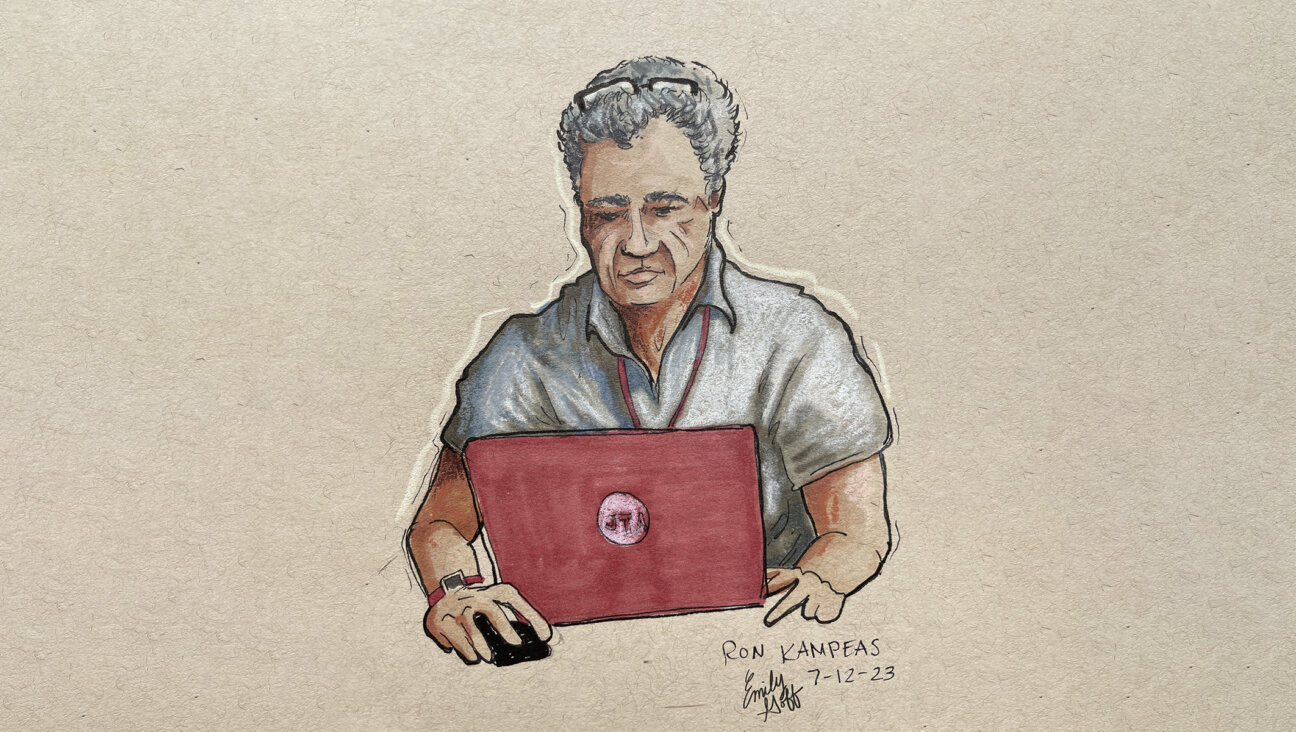The Jewish jazz master who Hunter S. Thompson thought could cure any ailment

Herbie Mann By Getty Images
I first met Herbie Mann in January 1979, when I noticed him bursting out of a phone booth in the parking lot of Tower Records in L.A. It wasn’t the noted jazz flutist in the flesh, of course, but rather the image of him on a six-foot-tall cover of his new album, “Super Mann,” which had been painted on the front of the store’s legendary Sunset Strip location.
To a 12-year-old with little frame of reference for popular music beyond whatever was in regular rotation on AM radio, the name Herbie Mann admittedly meant nothing. Between the album’s punning title and its goofy image of a balding and bearded older gent tearing off a suit and dress shirt to reveal a blue bodystocking emblazoned with a red-and-yellow “HM” shield, I figured this was some kind of humorous cash-in on the new “Superman” film, which had just been released the previous month. Maybe Herbie Mann was a standup comic, I thought.
That Herbie Mann was actually a musician didn’t become apparent to me until about two months later, when he appeared on “American Bandstand” to plug “Superman,” his new single. But even then, I had no clue that he was a jazz player of considerable renown; all I saw was a guy way older than the Bandstand demographic (maybe older than Dick Clark, even!), who was wearing a Panama hat and playing flute solos while two young women in matching tunics with the “HM” shield chanted “Superman! We love you Superman!” over a disco beat. I didn’t get it. A novelty song with the flute as featured instrument? What in the name of Bobby “Boris” Pickett was this?
I didn’t learn until many years later that Mann’s “Superman” (which ultimately reached #26 on the Billboard Hot 100) was not only a cover of a 1977 single by Puerto Rican disco diva Celi Bee, but that it was also the final burst of what was — at least for a jazz musician — an incredible and almost unprecedented run of commercial success. From 1963’s “Herbie Mann Live at Newport” to “Super Mann” 16 years later, Mann landed 22 albums in the Billboard 200, two of which — 1969’s “Memphis Underground” and 1975’s “Discothèque”—reached the relatively lofty positions of #20 and #27, respectively. Seven Mann singles released during that same stretch made both the U.S. pop and R&B charts, with 1975’s disco-fied “Hi-Jack” soaring the highest; the single not only made it to #14 on the Hot 100, but also topped the Billboard dance charts for three weeks.

At the Village Gate: Herbie Mann, circa 1954. By Getty Images
But there was so much more to Herbie Mann and his music than crossover hits. Born Herbert Jay Solomon in 1930 to Brooklyn Jews of Russian and Romanian descent, Mann began playing clarinet at the age of nine before he found his way to the tenor saxophone and the flute. Following his discharge from the Army, where he played sax in the military band, Mann intended to pursue a career as a jazz musician — but given that there was no shortage of talented sax players already wailing on the New York jazz scene, he switched to flute.
“I thought I had a great opportunity,” Mann told author Peter Westbrook in 2003, shortly before his death from prostate cancer, “because at the time you didn’t have many people playing jazz on the instrument.”
Though Mann waxed several well-received bop and post-bop albums during the 1950s, both as bandleader and sideman, he never felt completely comfortable with how the flute fit into the jazz conventions of the era. When New York DJ Symphony Sid suggested that his style of playing might mesh better with Latin percussion, Mann began gravitating toward more groove-oriented music, a shift that set him on course to eventually experiment with everything from Afro-Cuban jazz and Brazilian bossa nova to soul, funk, rock, blues, reggae and disco.
There were also occasional forays into Asian, Middle Eastern and Eastern European sounds, and even showtunes, but Mann — who often described his music as “Afro-Yiddish” — did his best and most defining work when his cool flute could dance over hot grooves. “With other instruments you can dictate the rhythmic energy,” he told Westbrook. “But with flute you can float on top of the waves rather than row the boat.”
Unfortunately, many jazz critics of the 1960s and ‘70s would have preferred Mann’s boat to capsize. His free-spirited approach to musical exploration — and the fact that his genre cross-pollinations often found considerable favor with the teeming masses — alienated the jazz press and stoked resentment among some of his colleagues. At best, Mann was viewed as a talented musician who forsook artistry for commerce; at worst, he was seen as an opportunistic hack.
“I was the Kenny G of the ‘60s, even though Kenny is a much better player than I was in the ‘60s,” Mann told Jazz Times in 1996. “It’s been a double-edged sword — success and crowd-pleasing. But I just figured it was on-the-job training.”
About a decade after I saw Mann perform on “American Bandstand,” I started to become interested in jazz. The record store I worked at stocked a good amount of classic jazz titles, so I was able to check out anything that looked potentially interesting to me, from Charlie Parker to Sonny Sharrock. But I avoided Mann’s records like the plague, largely due to the overwhelmingly negative critical consensus I’d absorbed while paging through old jazz mags.
I’d always shrugged off similar criticisms of Herb Alpert, another nice Jewish boy who’d made it big on the pop charts with jazzy (or at least jazz-adjacent) instrumentals; then again, Alpert never gave off creepy ‘70s swinger vibes, like Mann did with his saucy shirtless pose on the cover of 1971’s “Push Push,” an album whose packaging also featured a stylized illustration of a naked couple locked in the missionary position. (Push Push, geddit?)
Between that eyewash-inducing cover, the Grant Wood parody on the inner sleeve of 1970’s “Muscle Shoals Nitty Gritty” — Mann in overalls (but no shirt, of course) as a pitchfork-toting farmer doted on by a scantily-clad “hippie babe” — and the title of 1975’s “Waterbed” (a word that still retains a heavy “Eww!” factor for me to this day), I would have been thoroughly put off even if his reviews had been kinder.
But the more I delved into jazz history, the more I found threads leading back to Herbie Mann, and the more I started to think that maybe I ought to actually give him a listen. For one thing, the list of musicians who played in his bands and on his records during the 1960s and ‘70s was long and stellar, including serious cats like Dave Pike, Willie Bobo, Antonio Carlos Jobim, Clark Terry, Chick Corea, Ray Barretto, Babatunde Olatunji, Roy Ayers, Gary Burton, Joe Zawinul, King Curtis, Hubert Laws, Ron Carter, David “Fathead” Newman, Larry Coryell, Miroslav Vitous, Cornell Dupree, Bernard Purdie and Steve Gadd—not to mention Sonny Sharrock, my new favorite free jazz guitarist.
Sure, Pike talked some shit about Mann after they parted ways, but most of these guys wouldn’t have wasted their time with someone they considered a talentless dilettante, even if the paycheck was fat. Ditto for the guest players on his more rock- or disco-oriented albums, like Duane Allman, Albert Lee, Mick Taylor and Tony Levin, or the singers he worked with like Cissy Houston or Tamiko Jones, or producers like Nesuhi Ertegun, Joel Dorn, Tom Dowd and Arif Mardin.
And then there was the intriguing existence of Embryo Records, the label Mann launched in 1970. Distributed by Atlantic Records, which Mann had already been with for a decade, Embryo not only issued Mann’s own records, but also released challenging works by the diverse likes of Ron Carter, Attila Zoller, Miroslav Vitous, Tonto’s Exploding Headband and Phil Woods’ European Rhythm Machine — a clear case of an artist leveraging his own success to shine the spotlight on deserving artists with less obvious commercial potential. Indeed, as I would discover once I finally cracked Mann’s 1969 concert LP “Live at the Whisky a Go Go” (recorded with a band that included Ayers on vibes, Sharrock on guitar, Vitous on bass, Steve Marcus on tenor sax and Bruno Carr on drums), Mann was equally generous about shining the spotlight on his onstage sidemen. In fact, the tantalizingly brief clip of Mann in the Oscar-winning documentary “Summer of Soul,” which was recorded the same year as Live at the Whisky a Go Go, is highlighted by a typically bonkers Sharrock guitar outburst.
And while jazz critics didn’t dig Mann, one writer whose tastes I respected really did: Hunter S. Thompson. A man who certainly knew his medications, the great Gonzo journalist often cited Mann’s “Memphis Underground” — whose highlights include extended workouts on the soul classics “Hold On, I’m Comin’” and “Chain of Fools” that were recorded in Memphis with the house rhythm section of the famed American Sound Studio — as a certified cure for whatever ails ya, even suggesting that it “may be the best album ever cut by anyone.” If Herbie Mann was good enough for him, I figured, he was probably good enough for me.
While I can’t honestly say I’ve listened to every one of the well over a hundred records Herbie Mann played on during his lifetime, I do now consider myself a massive Mann fan, especially when it comes to his oft-criticized ‘60s and ‘70s output. Not only have I come to appreciate his open-minded efforts to experiment with a wide variety of other genres and influences, but I can now also hear the influence of Mann’s groove-centric playing in so many other recordings I love, from albums by fellow flautists Hubert Laws and Bobbi Humphrey to such flute-fired Blaxploitation film soundtracks as Isaac Hayes’ “Shaft” and Roy Ayers’ “Coffy,” and even ‘70s TV cop/detective show music like Jerry Goldsmith’s “Theme from ‘Barnaby Jones.’” (For a taste of Mann at his get-down finest, I highly recommend Varèse Sarabande’s 2017 compilation “The Very Best of Herbie Mann: It’s a Funky Thing,” which collects 15 of his most danceable singles from 1962’s “Comin’ Home, Baby” to “Superman.”)
Mann’s extensive catalog can be frustrating, however. For every out-and-out classic like “Memphis Underground,” 1962’s “Brazil, Bossa Nova & Blues,” 1968’s psychedelically-tinged “Windows Opened” or 1970’s mystical “Stone Flute,” there’s a half-dozen that are maddeningly, distractingly inconsistent. For example, 1966’s “Impressions of the Middle East” — an otherwise fascinating experiment combining brass with Middle Eastern stringed instruments—comes loaded with a stinkbomb rendition of Manfred Mann’s “Do Wah Diddy Diddy.”
Side one of “Discothèque” — which includes burning covers of Average White Band’s “Pick Up the Pieces” and LaBelle’s “Lady Marmalade” — may be the flat-out funkiest side he ever cut; unfortunately, side two immediately squanders the momentum with a limp take on Otis Redding’s “I Can’t Turn You Loose” and a dreary cover of The Carpenters’ “I Won’t Last a Day Without You,” before finishing up with a completely cringeworthy version of Bob Marley’s “Guava Jelly.”
And yet…
I ultimately can’t begrudge Mann any of those missteps, because so many of his dead-ends were clearly the result of an impressive willingness to give any song or style or collaboration a shot, just to satisfy his own wide-ranging musical curiosity.
“When I was 18, I only wanted purity, an 18‐year‐old’s idea of purity,” he told The New York Times in 1973. “Everything else was selling out. But I think it’s a much bigger lie to not do what you do best, only to satisfy somebody else. Life is too short for somebody else to set a standard for me about what my tastes in music are.”
I also cut Mann some slack because even his weaker albums have at least one fantastic track, and because there’s something in his tone and phrasing — regardless of what style of music he was assaying — that I have found to be exceptionally soothing, especially in these days of rampant horror and punishing stupidity.
The other day, completely wound up from watching GOP senators snapping like rabid weasels at Ketanji Brown Jackson, I threw “Windows Opened” on the turntable and turned the volume up to an appropriately brain-scrubbing level. By the time the final notes of the closing title track were ringing out, I felt transported, refreshed and downright human again. Sorry for ever doubting you, Herbie; you’ve been gone nearly 20 years now, but you’re still the Mann.
A message from our Publisher & CEO Rachel Fishman Feddersen

I hope you appreciated this article. Before you go, I’d like to ask you to please support the Forward’s award-winning, nonprofit journalism during this critical time.
We’ve set a goal to raise $325,000 by December 31. That’s an ambitious goal, but one that will give us the resources we need to invest in the high quality news, opinion, analysis and cultural coverage that isn’t available anywhere else.
If you feel inspired to make an impact, now is the time to give something back. Join us as a member at your most generous level.
— Rachel Fishman Feddersen, Publisher and CEO























